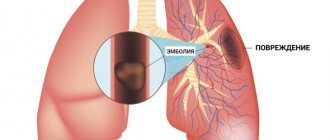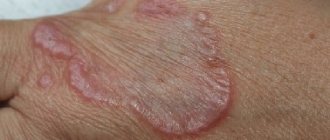Deep vein thrombosis (DVT) occurs when a blood clot (thrombus) forms in one or more deep veins in your body, usually in the legs. Deep vein thrombosis can cause leg pain or swelling, but may be asymptomatic.
- Symptoms of deep vein thrombosis
- Causes of deep vein thrombosis
- Risk factors
- Complications of DVT
- Prevention of thrombosis
DVT may be associated with diseases that affect the blood clotting process. A blood clot in your legs can also form if you have not moved for a long time, such as after surgery or an accident. But walking over extremely long distances can lead to the formation of blood clots.
Deep vein thrombosis is a serious condition because blood clots in your veins can travel through your bloodstream and become lodged in your lungs, blocking blood flow (pulmonary embolism). However, pulmonary embolism can occur without evidence of DVT.
When DVT and pulmonary embolism occur at the same time, it is called venous thromboembolism (VTE).
What is thrombophlebitis
Thrombophlebitis is an inflammation of the venous wall with the formation of a blood clot in the lumen of the vein.
Most often, thrombophlebitis occurs in the veins of the lower extremities, but in some cases it can be localized in the veins of the upper extremities, chest, and neck. Experts usually call inflammation and thrombosis of the superficial saphenous veins thrombophlebitis. In the case of deep vein thrombosis, another term is more often used - “ phlebothrombosis ”.
In the case of inflammation of the vascular wall, in the absence of a blood clot in the lumen of the vein, the term “ phlebitis ” is used.
Stages
The sequence of development of the disease is as follows:
- Acute stage
. Clinical signs of thrombophlebitis are bright and appear unexpectedly. The temperature rises, the skin around the affected area turns red, and the patient shudders. If treatment is started within two weeks, the development of the disease can be avoided. The blood clot will dissolve. The duration of exacerbation is up to one month. - Subacute stage
. Lasts up to two months. Signs of the disease subside, but do not fade away. The skin remains red and the swollen veins turn blue. The swelling goes away, but the seals remain. - Chronic stage
. Diagnosed two to three months after the disease is detected. Symptoms are either absent or worsened. During remission, the limbs remain swollen, quickly become tired and itchy, but there is no pain. Discomfort occurs in the lower extremities when walking for a long time.
Causes of thrombophlebitis
The main causes of venous thrombosis:
- inflammatory process (local and/or general),
- slowing down the flow of blood through the venous vessels, leading to venous stagnation (for example, due to varicose veins),
- hereditary or acquired tendency of the blood to form blood clots (coagulopathies or thrombophilic conditions),
- damage to the venous wall (sometimes even minor trauma to the vessel, for example, catheterization of a vein).
Thrombosis
Venous thrombosis of the lower extremities is a more dangerous condition than thrombophlebitis. With thrombosis, blood clots (thrombi) appear in the deep veins, which, under certain conditions, can enter the pulmonary artery and block (pulmonary embolism).
Causes of thrombosis:
- increased blood clotting;
- injury to the inner wall of blood vessels;
- slow blood flow as a result of a person sitting or lying for a long time;
- pregnancy.
Symptoms of thrombosis:
- swelling of the affected limb as a result of slowed blood flow;
- blueness of the skin of the leg;
- darkening of the skin on the leg, which can even with a minor injury lead to the formation of a trophic ulcer;
- unexpected pain in the leg (due to inflammation in the bloodstream).
But most often, thrombosis of the veins of the lower extremities is characterized by the absence of pain in the patient. Depending on which veins are damaged by the clot, your ankle, foot, or thigh may swell. Overnight, while the person rests in a horizontal position, the swelling may disappear.
Symptoms of thrombophlebitis
- soreness,
- the appearance of local swelling of the limb,
- temperature rise,
- thickening and redness along the affected vein.
In the case of thrombophlebitis of the superficial veins, the patient may notice a gradual increase in the intensity of the changes described above over several days.
If you have these symptoms, you should definitely consult a specialist.
However, with deep vein thrombosis (phlebothrombosis), the main symptom is most often swelling of the affected limb, although it should be remembered that many patients with this form of the disease may not have any symptoms for a long time.
If swelling and pain are severe, and are also accompanied by high fever or shortness of breath with coughing attacks or chest pain, it is necessary to call an ambulance team.
These symptoms may indicate the development of deep vein thrombosis, which significantly increases the likelihood of a blood clot breaking off and migrating into the vessels of the lungs.
Mechanism of thrombus formation
The formation of a blood clot always follows one scenario: first, damage occurs (trauma to the vessel wall), platelets rush to the site of damage, which stick together into a strong clot and adhere to the wound. Next, fibrin threads are formed, and the vessel receives a “patch.” Over time, the tissues are restored, the blood clot dissolves as unnecessary.
A useful mechanism that saves people from blood loss due to injury can become dangerous when there is an excess of platelets - thrombophilia. An excess of these blood cells results in blood clots that are too large for minor injuries. The second important factor in thrombus formation is the very presence of damage. Thrombosis becomes a pathology if it begins in the absence of injury to the vascular wall.
Risk factors for the development of thrombophlebitis
- pregnancy, childbirth, gynecological operations (including abortions).
- varicose veins;
- prolonged bed rest (for example, after surgical and orthopedic operations);
- infectious diseases;
- stroke leading to paralysis of the limbs;
- motionless body position during a long trip by car or plane;
- obesity;
- oncological diseases (including surgical treatment of malignant neoplasms, radiation therapy and chemotherapy);
- dehydration;
- the use of hormonal contraceptives and other sex hormone preparations for the purpose of replacement therapy;
- increased blood clotting (hyperhomocysteinemia, antiphospholipid syndrome, etc.);
- puncture and/or venous catheterization.
The more risk factors a patient has, the higher the risk of developing thrombophlebitis.
If you have one or more factors from the above list, consult a specialist about methods of preventing venous thrombosis.
Folk remedies
Along with drug treatment, traditional methods can give good results. However, you should not blindly believe and thoughtlessly try everything on yourself. The doctor should control the treatment regimen, the admissibility and effectiveness of folk remedies.
- White cabbage. Cabbage leaves need to be softened, one side greased with oil and secured with a bandage on the painful area. Leave the compress on all night.
- Kalanchoe pinnate. Grind the leaves and fill the jar halfway with them. Fill the rest of the jar with vodka. Next, leave for 7 days in a dark place, shaking the contents periodically. Strain the finished tincture. Rub the sore leg from the foot to the groin in the direction of the vein. So for a month 2 rubles/day.
- Apple vinegar. Mix 2 teaspoons of vinegar and honey in a glass of water. Drink half a glass before meals 2 times a day.
- Mumiyo. You can make a tincture for internal use and ointment:
- for the tincture you need to mix 10g of mumiyo with 0.5l of water - drink 1 tablespoon/1 ruble per day, 10 days
- For the ointment, you need to mix mumiyo with Vaseline (or peach oil) in a ratio of 1 to 5 - smear 3 times a day, leave for 1 hour, 10 days.
Confirmation of the diagnosis of thrombophlebitis
During the examination, the specialist individually selects the required minimum of research for each specific case. To confirm or exclude thrombophlebitis of the lower extremities, your doctor may choose one of the following diagnostic methods:
- Blood tests (clinical blood test, coagulogram, D-dimer);
- Venography (X-ray examination of the venous bed using the injection of a contrast agent that stains the vessels from the inside). Currently, due to the development of low-traumatic and highly informative research methods (primarily duplex angioscanning), it is used extremely rarely;
- Computed tomography and magnetic resonance imaging in vascular mode - performed in situations where ultrasound diagnostic methods are not very informative;
- Ultrasound diagnostic methods (Dopplerography and duplex angioscanning) are currently the “gold standard” for diagnosing thrombophlebitis.
After a diagnosis has been established, you may need additional diagnostics to identify the causes of thrombophlebitis, as well as control studies to clarify the nature of the dynamics of the pathological process.
Treatment methods for thrombophlebitis
Treatment of thrombophlebitis of superficial veins
In this case, the specialist may recommend treatment on an outpatient basis. The list of recommendations may include medications:
- having an anti-inflammatory effect (non-steroidal anti-inflammatory drugs, for example: Nimesil, Ibuprofen, Diclofenac, Nise, etc.);
- local remedies (compresses and ointments);
- compression methods (elastic bandages or compression hosiery, etc.);
- phlebotonic agents (Detralex, Phlebodia, Antistax, Vasoket, etc.).
With thrombophlebitis of the superficial veins, the patient rarely needs hospitalization and, with proper treatment, as well as careful adherence to medical recommendations, relief usually occurs quickly.
With the progression of superficial thrombophlebitis (growth of the thrombus border), surgical prevention of thromboembolism (separation and migration of thrombotic masses into the vessels of the lungs) and the spread of thrombosis to the deep vein system may be required. Surgical intervention in this case is performed according to urgent indications and most often consists of ligating the thrombosed superficial vein (great or small saphenous vein) at the point where it flows into the deep vein system and, if possible, removing varicose veins (thrombosed and non-thrombosed) veins.
Treatment of deep vein thrombosis
Drug therapy
Injections of blood thinning drugs - anticoagulants (heparin or its modern analogues: Clexane, Fraxiparin, Fragmin). After heparin therapy, long-term use of the tablet form of another blood thinning drug, warfarin, may be prescribed. Treatment with anticoagulants is carried out to prevent the growth of a blood clot and prevent recurrence of venous thrombosis.
If your doctor has prescribed you warfarin, strictly follow the instructions for taking the drug and monitoring your blood clotting.
Warfarin is a powerful drug that can cause a number of dangerous side effects if you do not follow your doctor's instructions.
Compression therapy
The use of elastic bandages and the selection of individual compression hosiery is one of the main tools for therapeutic effects, as well as prevention for deep vein thrombosis. Consult a specialist about possible compression therapy methods in your case.
Implantation of vena cava filter
In some cases, especially if there are contraindications to blood-thinning drugs or their ineffectiveness, a vena cava filter device can be installed in the main vein of the patient's body (inferior vena cava) to prevent the migration of detached fragments of blood clots from the veins of the lower extremities to the vessels of the lungs. The vena cava filter acts as a trap for detached blood clots. The filter can be installed for a certain period of time (3-4 weeks) or permanently. This procedure is most often performed under local anesthesia and does not require a long hospital stay.
Surgery
Thrombectomy, venous angioplasty and venous bypass.
In some cases, it may be necessary to perform a surgical intervention aimed at removing thrombotic masses of large venous trunks (thrombectomy) in the lower extremities, pelvis or abdomen. To treat long-standing blockage, bypass surgery or minimally traumatic intervention (stenting) of the affected segment of the main vein is sometimes performed.
The volume and nature of surgical intervention for deep vein thrombosis is determined individually by the vascular surgeon.
Thrombolysis
Dissolution of thrombotic masses with the help of special drugs - thrombolytics (urokinase, actilise, etc.). This procedure can only be performed in the early stages of the disease and has a number of special contraindications.
Sources
- Bogachev V.Yu. Thrombophlebitis (thrombosis of superficial veins): modern standards of diagnosis and treatment / V.Yu. Bogachev [et al.] // Outpatient surgery. — 2021. — No. 3-4 (63-64). — P. 16-23.
- Kuzmichev D.E. Pathomorphological findings. Thrombophlebitis / D.E. Kuzmichev [et al.] // Health care of Ugra: experience and innovations. - 2020. - No. 1. - P. 53-56.
- Marushchak E.A. Modern methods of ultrasound diagnosis of venous thrombosis of the inferior vena cava system / E.A. Marushchak, A.R. Zubarev // Outpatient surgery. Stationary replacement technologies. - 2014. - No. 3-4 (55-56). — P. 38-47.
Diet for thrombophlebitis
A large amount of fresh vegetables, fruits, fiber, nuts, cereals, whole grain breads. Among products of plant origin, the following also have a beneficial effect on venous diseases:
- ginkgo biloba,
- ginger,
- red capsicum,
- valerian root,
- garlic,
- hawthorn berries.
Nutritional supplements and vitamins:
- vitamins C, A, E and B6,
- linseed oil,
- magnesium and calcium (in combination),
- Pycnogenol
Disease prevention
Thrombophlebitis is a very serious disease that affects people of all ages and all genders. Therefore, it is important to identify the disease as early as possible and begin treatment as quickly as possible. As preventive measures to prevent thrombophlebitis, it is necessary to promptly treat chronic venous diseases, follow a diet (limit the amount of animal fats in the diet, eat more berries, fruits and vegetables high in ascorbic acid and vitamin P), lead an active lifestyle and give up bad habits.
Recommendations for changing the lifestyle of patients with thrombophlebitis
- Elevated position of the lower extremities during rest and sleep;
- Avoid prolonged static loads;
- Avoiding heavy physical activity (weight lifting);
- Avoid overheating and dehydration (long stay in the bathhouse);
- Wear compression hosiery of the required compression class (determined by a specialist);
- Limiting static loads (avoid sitting for long periods of time, standing without moving);
- Constant physical activity - walking, swimming, cycling;
- Selection of comfortable shoes and orthopedic insoles.










